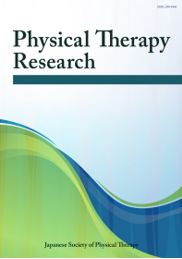バーチャルイシュー
26 巻, 3 号
選択された号の論文の7件中1~7を表示しています
- |<
- <
- 1
- >
- >|
Review
-
2023 年26 巻3 号 p. 71-77
発行日: 2023年
公開日: 2023/12/20
[早期公開] 公開日: 2023/11/18PDF形式でダウンロード (1310K) -
2023 年26 巻3 号 p. 78-88
発行日: 2023年
公開日: 2023/12/20
[早期公開] 公開日: 2023/11/25PDF形式でダウンロード (237K)
Original Article
-
2023 年26 巻3 号 p. 89-97
発行日: 2023年
公開日: 2023/12/20
[早期公開] 公開日: 2023/10/27PDF形式でダウンロード (7978K) -
2023 年26 巻3 号 p. 98-105
発行日: 2023年
公開日: 2023/12/20
[早期公開] 公開日: 2023/11/09PDF形式でダウンロード (353K)
Brief Report
-
2023 年26 巻3 号 p. 106-113
発行日: 2023年
公開日: 2023/12/20
[早期公開] 公開日: 2023/09/08PDF形式でダウンロード (1289K)
Physical Therapy Japan Vol.49 (2022) ABSTRACTS
-
2023 年26 巻3 号 p. 114-141
発行日: 2023年
公開日: 2023/12/20
PDF形式でダウンロード (983K)
Editorial Board
-
2023 年26 巻3 号 p. e3
発行日: 2023年
公開日: 2023/12/20
PDF形式でダウンロード (34K)
- |<
- <
- 1
- >
- >|
